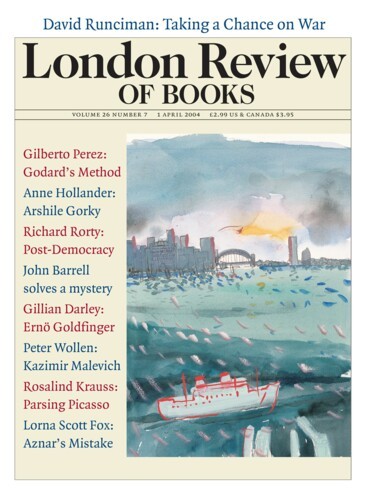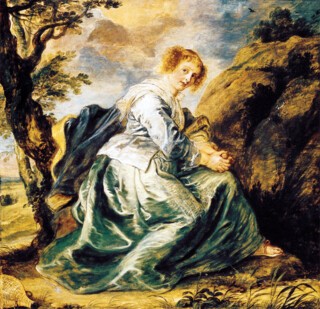Astraw poll suggests that Rubens is not popular. How can you persuade those who can’t get on with him to look longer? You can offer opinions: what they find too fleshy I approve as sensual. When they complain of facile energy, empty of meaning, I praise the articulation of fictive space. But giving different labels doesn’t advance the case. So why defend at all? Why not just celebrate and hope that enthusiasm will be infectious? Mainly because some of what those who don’t like the paintings find repugnant is repugnant to me too. To love Rubens is to accept that he fails where other great painters succeed. No painter can do everything. But the source of Rubens’s failures may also be the source of his unparalleled energy, charm and inventiveness.
Take the way he paints Jesus’ dead body as it is taken down from the cross. His greatest version of this subject is in Antwerp, but there are two others in the big Rubens exhibition at the Palais des Beaux-Arts in Lille (until 14 June). In the more striking of the two, which lives in Lille, Christ is pale, elegant, perfectly muscled, sculptural. Compare this version of the dead body with the body in Titian’s late Entombment in the Prado. Titian’s Christ looks older. His heavily muscled arm can also be compared to antique sculpture. But where Rubens suggests a sleeping Apollo, Titian brings to mind a dying gladiator. In Rembrandt’s version the body is weak, not muscular. Pathos is evoked in all three, but Rubens advertises imminent, triumphant resurrection so plainly that death is not awful. Titian evokes masculine stoicism, noble grief, Rembrandt’s Christ is human – this is a body like the bodies of those we love, touching in its imperfection. And it is dead.
The first two contain the surrounding figures in a shallow space. Rembrandt stands back. In Rubens’s picture the strong men who are lowering the body drive the composition; the lamenting women are bystanders. Titian shows muscular supporting figures which marvellously suggest the weight of the dead body, but the most telling expressions are those of the women. Rembrandt shows a crowd – the individuals we can name are hardly more prominent than anonymous bystanders. Of the three, Rubens seems least sincere, the most theatrical in the sense that what he is offering could be a tableau set up with models. When you look at the way he put his paintings together you begin to understand why his statement might be the least coherent.
The Lille show ends with a room of drawings; in some ways it would be easier if it began with them. You learn that the style of each kind of drawing was adapted to a purpose. These sheets were not ends in themselves. Rembrandt’s drawings were collected in his lifetime; Rubens’s were not: he kept them – they were tools of the trade.
First come the scribbles (that is how they are described in early inventories), sketches for compositions or parts of compositions, more often than not in pen and ink, in which swift, sometimes confusing lines swirl and weave round a focus. In drawings like these the kinetic essence of a composition is drawn out of what could have started as abstract calligraphy. You see figures emerge from a net of lines. You are reminded that even in his paintings of standing figures, movement is always there.
Second in degree of finality are the oil sketches. They also show how the bodies in a picture will move and intertwine, but their purpose was different. In them you have a miniature of the finished painting – open to revision, but in colour, and perfectly legible. These would be sent to patrons to show what was planned.
Third are the studies from life, usually done in chalk. The sureness of touch is wonderful. The outline of a foreshortened arm or leg and the shading which explains the muscles seem to have been made with perfect economy and without revision; his portrait drawings, particularly those of his family, have the same directness. Yet it is, in one way, an illusion, as a fourth kind of drawing – studies made after antique sculpture and paintings – shows. The hand which knows just how the muscle of a twisted arm bulges learned what it saw, or at least how to represent it, from art as much as from life. Thus the poses of figures plucked out of the calligraphic scribble were understood by drawing from models; they are real but set up, lifelike but not necessarily true to life.
With this material in front of you the extent to which his painting was an art of quotation – quotation from the antique, from other artists, but most of all from his own separate observations of plants, animals, landscapes, things and people – becomes clear. It is an art in which things are assembled, borrowed, adapted.
If you ask why his big pictures do not become dead and dull the way those of Ingres (who made wonderfully subtle preparatory life drawings) tend to, the reason must, in part, lie in the fact that no stage was so finished as to make the next dutifully mechanical. The moves from scribble to sketch; from sketch to life drawing; from all those to the final canvas left much still to be decided. An unfinished painting in Lille – Henri IV at the Battle of Ivry – offers evidence of the final moves.
Rubens made no squared up cartoons of paintings. In the Battle of Ivry figures of men and animals have been firmly drawn in dark outlines with a broad brush – it is possible the lines follow an underlying drawing in chalk. Some areas have already begun to be worked up. This way of doing things fitted well with the use of assistants, who could emulate Rubens’s style, and whose work could be pulled together by his final touches. Even in big pictures, when you get close, you find much of what works best takes the form of lively drawing with a brush.
What is lacking in the spirit of religious pictures like the Deposition may be a consequence of this way of working. The parts are alive, for the brushwork is, at its best, enlivening, but the central content – the resolution of the elements implied in the first scribble – works best when meaning lies in the way figures dance, heave or twist. In subjects where a moment of quiet has arrived, where the mime has frozen into a tableau, the relationship between figure and figure, between you and the protagonists may fail. The emotional range can seem oddly narrow when you consider the violence of what is shown and the story illustrated; it is significant that faces and the expressions on them fall into stock types.
At their best there are no pictures which make the act of painting seem more delicious. Colour; the movement of whirling couples; the textures of fabric, fur, the pelts of animals, the bark of trees: all these observed gluttonously and recorded in strokes as rhythmical as the dance itself, as sleek as the fur, as springy as the flesh.
The most revealing commentary on Rubens is the art of painters like Watteau and Delacroix who admired and learned from him. They too made pictures which keep the final act fresh. Another kind of picture – those like, say, Raphael’s late works – can make Rubens seem ramshackle. But the closer Rubens comes to sublime, Raphaelesque order, to classical gravitas, the less one feels what is at the heart of his greatest work: the warmth of his appetite for the look of things.
So should you go to Lille? If you are a devotee, yes. But there is no big landscape in Lille as sublime as the Rainbow Landscape in the Wallace Collection. The portrait in Lille of his first wife is, it’s true, even more winning than the National Gallery’s Straw Hat, but the National Gallery’s Sabine Women and Judgment of Paris are better than the nearest equivalents in Lille. Moreover, some of the best things there come from London: the queen’s St George and the Dragon and the National Gallery’s Allegory of War and Peace, for example. The pretty, silly young woman playing the title role in Hagar in the Wilderness is usually one of the pleasures of the Dulwich Gallery. The Banqueting House ceiling is the only major Rubens architectural decoration still in its original setting. Many oil sketches are to be seen at the Wallace and the Courtauld. Lille has borrowed a number of drawings from the British Museum. You must make a trip to Antwerp for the altarpieces, and to Paris for the Louvre’s Marie de’ Medici sequence. But do that, and wait for the rest to come home if you want Rubens whole.
Send Letters To:
The Editor
London Review of Books,
28 Little Russell Street
London, WC1A 2HN
letters@lrb.co.uk
Please include name, address, and a telephone number.


